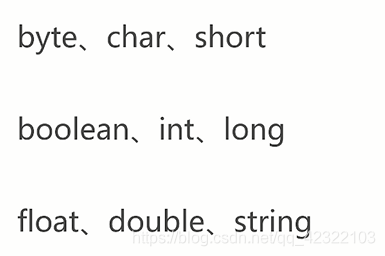 Copyright: Attribution, allow others to create paper-based, and must distribute paper (based on the original license agreement with the same license Creative Commons )
Copyright: Attribution, allow others to create paper-based, and must distribute paper (based on the original license agreement with the same license Creative Commons )
Article Directory
Process
TCP transport initial configuration
TCP server listens initialization link
Initialization client initiates a link operation
Socket server link processing
The client and server interaction
The client sends a simple byte
The server receives the client sends data
Echo message server, the client identifies echo message
Basic type data transmission

This part is very important
Code demonstrates
Server.java
server
import java.io.IOException;
import java.io.InputStream;
import java.io.OutputStream;
import java.net.Inet4Address;
import java.net.InetSocketAddress;
import java.net.ServerSocket;
import java.net.Socket;
import java.nio.ByteBuffer;
public class Server {
private static final int PORT = 20000;
public static void main(String[] args) throws IOException {
//创建基础的ServlerSocket
ServerSocket server = createServerSocket();
//初始化
initServerSocket(server);
// 绑定到本地端口上
server.bind(new InetSocketAddress(Inet4Address.getLocalHost(), PORT), 50);
System.out.println("服务器准备就绪~");
System.out.println("服务器信息:" + server.getInetAddress() + " P:" + server.getLocalPort());
// 等待客户端连接
for (; ; ) {
// 得到客户端
Socket client = server.accept();
// 客户端构建异步线程
ClientHandler clientHandler = new ClientHandler(client);
// 启动线程
clientHandler.start();
}
}
private static ServerSocket createServerSocket() throws IOException {
// 创建基础的ServerSocket
ServerSocket serverSocket = new ServerSocket();
// 绑定到本地端口20000上,并且设置当前可允许等待链接的队列为50个
//serverSocket = new ServerSocket(PORT);
// 等效于上面的方案,队列设置为50个
//serverSocket = new ServerSocket(PORT, 50);
// 与上面等同
// serverSocket = new ServerSocket(PORT, 50, Inet4Address.getLocalHost());
return serverSocket;
}
private static void initServerSocket(ServerSocket serverSocket) throws IOException {
// 是否复用未完全关闭的地址端口
serverSocket.setReuseAddress(true);
// 等效Socket#setReceiveBufferSize
serverSocket.setReceiveBufferSize(64 * 1024 * 1024);
// 设置serverSocket#accept超时时间
// serverSocket.setSoTimeout(2000);
// 设置性能参数:短链接,延迟,带宽的相对重要性
serverSocket.setPerformancePreferences(1, 1, 1);
}
/**
* 客户端消息处理
*/
private static class ClientHandler extends Thread {
private Socket socket;
ClientHandler(Socket socket) {
this.socket = socket;
}
@Override
public void run() {
super.run();
System.out.println("新客户端连接:" + socket.getInetAddress() +
" P:" + socket.getPort());
try {
// 得到套接字流
OutputStream outputStream = socket.getOutputStream();
InputStream inputStream = socket.getInputStream();
byte[] buffer = new byte[256];
int readCount = inputStream.read(buffer);
ByteBuffer byteBuffer = ByteBuffer.wrap(buffer, 0, readCount);
// byte
byte be = byteBuffer.get();
// char
char c = byteBuffer.getChar();
// int
int i = byteBuffer.getInt();
// bool
boolean b = byteBuffer.get() == 1;
// Long
long l = byteBuffer.getLong();
// float
float f = byteBuffer.getFloat();
// double
double d = byteBuffer.getDouble();
// String
int pos = byteBuffer.position();
String str = new String(buffer, pos, readCount - pos - 1);
System.out.println("收到数量:" + readCount + " 数据:"
+ be + "\n"
+ c + "\n"
+ i + "\n"
+ b + "\n"
+ l + "\n"
+ f + "\n"
+ d + "\n"
+ str + "\n");
outputStream.write(buffer, 0, readCount);
outputStream.close();
inputStream.close();
} catch (Exception e) {
System.out.println("连接异常断开");
} finally {
// 连接关闭
try {
socket.close();
} catch (IOException e) {
e.printStackTrace();
}
}
System.out.println("客户端已退出:" + socket.getInetAddress() +
" P:" + socket.getPort());
}
}
}
Client
Client.java
import java.io.IOException;
import java.io.InputStream;
import java.io.OutputStream;
import java.net.Inet4Address;
import java.net.InetSocketAddress;
import java.net.Socket;
import java.net.SocketException;
import java.nio.ByteBuffer;
public class Client {
private static final int PORT = 20000; //远程服务器的端口
private static final int LOCAL_PORT = 20001; //本地服务期的端口
public static void main(String[] args) throws IOException {
Socket socket = createSocket(); //创建
initSocket(socket); //初始化
//进行连接操作
// 链接到本地20000端口,超时时间3秒,超过则抛出超时异常
socket.connect(new InetSocketAddress(Inet4Address.getLocalHost(), PORT), 3000);
System.out.println("已发起服务器连接,并进入后续流程~");
System.out.println("客户端信息:" + socket.getLocalAddress() + " P:" + socket.getLocalPort());
System.out.println("服务器信息:" + socket.getInetAddress() + " P:" + socket.getPort());
try {
// 发送接收数据
todo(socket);
} catch (Exception e) {
System.out.println("异常关闭");
}
// 释放资源
socket.close();
System.out.println("客户端已退出~");
}
private static Socket createSocket() throws IOException {
/*
// 无代理模式,等效于空构造函数
Socket socket = new Socket(Proxy.NO_PROXY);
// 新建一份具有HTTP代理的套接字,传输数据将通过www.baidu.com:8080端口转发
//注意这是代理
Proxy proxy = new Proxy(Proxy.Type.HTTP,
new InetSocketAddress(Inet4Address.getByName("www.baidu.com"), 8080));
socket = new Socket(proxy);
// 新建一个套接字,并且直接链接到本地20000的服务器上
socket = new Socket("localhost", PORT);
// 新建一个套接字,并且直接链接到本地20000的服务器上
socket = new Socket(Inet4Address.getLocalHost(), PORT);
// 新建一个套接字,并且直接链接到本地20000的服务器上,并且绑定到本地20001端口上
socket = new Socket("localhost", PORT, Inet4Address.getLocalHost(), LOCAL_PORT);
socket = new Socket(Inet4Address.getLocalHost(), PORT, Inet4Address.getLocalHost(), LOCAL_PORT);
*/
Socket socket = new Socket();
// 绑定到本地20001端口
socket.bind(new InetSocketAddress(Inet4Address.getLocalHost(), LOCAL_PORT));
return socket;
}
private static void initSocket(Socket socket) throws SocketException {
// 设置读取超时时间为2秒
socket.setSoTimeout(2000);
// 是否复用未完全关闭的Socket地址,对于指定bind操作后的套接字有效
socket.setReuseAddress(true);
// 是否开启Nagle算法
socket.setTcpNoDelay(true); //解决糊涂窗口综合征和拥塞的问题
// 是否需要在长时无数据响应时发送确认数据(类似心跳包),时间大约为2小时
//心跳包就是在客户端和服务器间定时通知对方自己状态的一个自己定义的命令字,按照一定的时间间隔发送,类似于心跳,所以叫做心跳包。
socket.setKeepAlive(true);
// 对于close关闭操作行为进行怎样的处理;默认为false,0
// false、0:默认情况,关闭时立即返回,底层系统接管输出流,将缓冲区内的数据发送完成
// true、0:关闭时立即返回,缓冲区数据抛弃,直接发送RST结束命令到对方,并无需经过2MSL等待
// true、200:关闭时最长阻塞200毫秒,随后按第二情况处理
socket.setSoLinger(true, 20);
// 是否让紧急数据内敛,默认false;紧急数据通过 socket.sendUrgentData(1);发送
socket.setOOBInline(false);
//发送紧急数据
// 设置接收发送缓冲器大小
socket.setReceiveBufferSize(64 * 1024 * 1024);
socket.setSendBufferSize(64 * 1024 * 1024);
// 设置性能参数:短链接,延迟,带宽的相对重要性
socket.setPerformancePreferences(1, 1, 0); //这个主要是权重 与值的大小并无多大关系
}
private static void todo(Socket client) throws IOException {
// 得到Socket输出流
OutputStream outputStream = client.getOutputStream();
// 得到Socket输入流
InputStream inputStream = client.getInputStream();
byte[] buffer = new byte[256];
ByteBuffer byteBuffer = ByteBuffer.wrap(buffer);
// byte
byteBuffer.put((byte) 126);
// char
char c = 'a';
byteBuffer.putChar(c);
// int
int i = 2323123;
byteBuffer.putInt(i);
// bool
boolean b = true;
byteBuffer.put(b ? (byte) 1 : (byte) 0);
// Long
long l = 298789739;
byteBuffer.putLong(l);
// float
float f = 12.345f;
byteBuffer.putFloat(f);
// double
double d = 13.31241248782973;
byteBuffer.putDouble(d);
// String
String str = "Hello你好!";
byteBuffer.put(str.getBytes());
// 发送到服务器
outputStream.write(buffer, 0, byteBuffer.position() + 1);
// 接收服务器返回
int read = inputStream.read(buffer);
System.out.println("收到数量:" + read);
// 资源释放
outputStream.close();
inputStream.close();
}
}
Tools:
Methods significance such as name
public class Tools {
public static int byteArrayToInt(byte[] b) {
return b[3] & 0xFF |
(b[2] & 0xFF) << 8 |
(b[1] & 0xFF) << 16 |
(b[0] & 0xFF) << 24;
}
public static byte[] intToByteArray(int a) {
return new byte[]{
(byte) ((a >> 24) & 0xFF),
(byte) ((a >> 16) & 0xFF),
(byte) ((a >> 8) & 0xFF),
(byte) (a & 0xFF)
};
}
}
First run the server running the client

